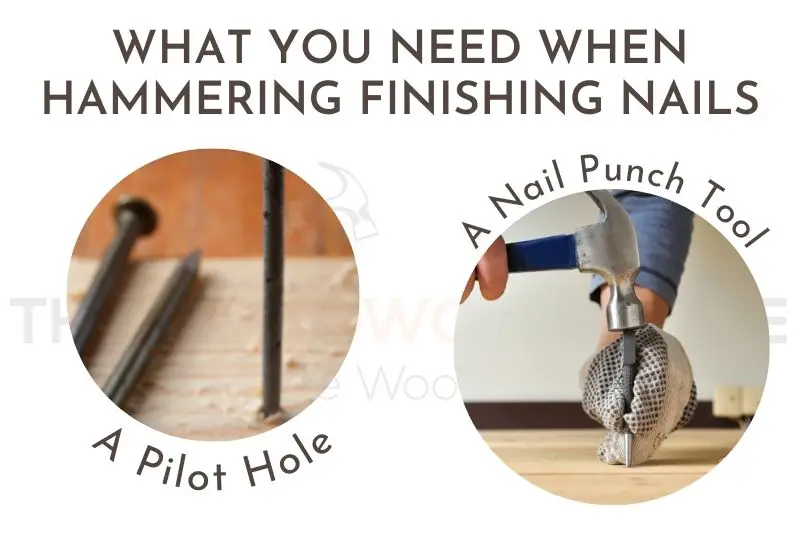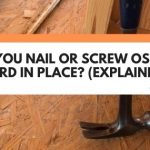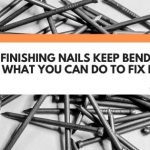An often-overlooked detail, when it comes to installing baseboards, is the installation of quarter round molding. This type of molding can be used to hide floor gaps and give your baseboards a more uniform appearance.
By installing quarter round molding, you also remove the need for caulk, which can be difficult to remove and is often not suitable for very large gaps.
So, in this post, we explain why finishing nails are often the best choice for installing quarter round. You’ll also learn what the key difference is between brad nails and finish nails.
And keep reading to find out how you can avoid bending finish nails (as you hammer them into quarter round molding).

This post may contain affiliate links to products that we receive a commission for (at no additional cost to you). Learn more here.
What Is The Point Of Quarter Round Molding?
Basically these particular moldings are there to hide gaps at the bottom of baseboard installation.
It’s actually one of a few different ways to cover up those otherwise unsightly imperfections. For example, sometimes shoe molding, (also referred to as a base shoe), is used instead of quarter rounds.
And What Nails Do You Use For Quarter Round Molding?
The best type of nails to use with this particular type of molding is a finish nail. These nails have enough holding power to keep molding, baseboard and trim, in place.
But, these nails can leave behind some very visible nail holes. So, be prepared to fill in those finish nail puncture holes with putty, if you want a seamless looking installation.
Related Post: MDF Vs Pine Crown Molding (Is MDF Better Than Natural Solid Wood?)
What About Brad Nails? What’s The Difference Between Using A Brad Nail Vs A Finishing Nail?
Brad nails are 18 gauge (18ga) nails. While finishing nails are either 15 gauge or 16 gauge.
Now, brad nails are shorter than finishing nails. So if you use them on thickly cut molding, they will have less holding power — if they even manage to punch all the way through that molding in the first place.
So, brad nails are better suited for lightweight wood crafts. And they’re sometimes used to hold wood glue joints in place as they dry.
You can discover more about brad nailers in our handy beginners product guide right here on The Woodwork Place. Simply click here to learn more: Best Cordless Brad Nailers [Reviewed]
And Can You Really Use A Brad Nailer For Quarter-Round Installations?
If that molding is very lightweight and fairly thin, then an 18 gauge nail should be able to punch right through it.
Which is fantastic for you, time wise, since brad nails don’t leave behind noticeable puncture holes. So, you don’t need to spend a lot of time applying putty into those tiny holes.
Related Post: Can You Really Use Cove Molding Instead Of Quarter Round Molding?
So, What Are Finishing Nails Good For (If You Can Use Brad Nails Instead)?
Well, brad nails simply don’t have the same staying power as a finish nail. You can use a finish nail on stairs, frames, and even on floorboards. And once installed, those nails will stay affixed.
However, brad nails don’t have anywhere near the same level of staying power. This is why finishing nails are almost always the go-to option for affixing baseboards.
Can You Hammer Finishing Nails? Or Should You Only Use A Nailer?
You can hammer finishing nails, but not directly. You’ll only end up bending the nail if you do that.
Instead, you need to use something called a ‘nail punch’. This handy hammer helper will allow you to hit the nail dead center every time.

And if you want to learn more about how to prevent finishing nails from bending, then check out our post: Why Finishing Nails Keep Bending (And What You Can Do To Fix It). In that post, we dive into what you can do to make sure you drive finishing nails straight into molding.
To Sum Up, Here Are The 3 Key Takeaways From This Post…
- 1). Quarter round moldings help mask floor gaps and flaws in baseboard installations.
- 2). You should use 15 gauge or 16 gauge finish nails to affix quarter round molding.
- 3). And, if you are manually hammering finishing nails, use a nail set in order to avoid bending them.


